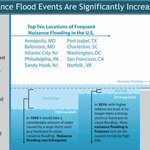Oceanography

Interpreting snow depth records from past decades is as much art as science. Even into the 1990s, Soviets on Arctic drifting sea ice used meter sticks and handwritten logs to record snow depth. Today, things are a lot more accurate. Airborne measurements are validated by researchers on the ground using automated probes similar to a ski pole.
Accuracy is important. The public has become concerned about what is happening at the poles, and so research led by NASA and the University of Washington combined data collected by ice buoys and NASA aircraft with historic data from ice…

Between Greenland and Spitsbergen, scientists have found the scours on the sea bed left behind by gigantic icebergs - about three times the height of the Empire State Building. The five lineaments, at a depth of 1,200 meters, are the lowest-lying iceberg scours yet to be found on the Arctic sea floor, and provide insight into the dynamics and the extent of last Ice Age and the Arctic ice sheet thousands of years ago.
"Whenever icebergs run aground, they leave scours on the seabed. Depending on their depth and location, those markings may continue to exist over long periods of time,"…

As the complex story of climate change unfolds, many of the forecasts are grim, but there are exceptions - the lowest-oxygen environments in the ocean would get now get worse, they may improve if climate change weakens the trade winds. Areas of extreme low-oxygen waters could shrink.
Warmer water contains less gas, so climate change is expected to reduce oxygen levels worldwide. Observations show this is already taking place in many places. Declines during the past 20 years in the tropical low-oxygen zones, the lowest-oxygen waters on the planet, had led to a 2008 study proposing that these…

Mercury is a naturally occurring element and a part of human enterprises like burning coal and making cement and compact fluorescent light bulbs.
Knowing how much of both natural and unnatural mercury is bioavailable - uptaken by animals and humans— is important in international agreements to protect humans and the environment from mercury emissions and establishing public policies behind warnings about seafood consumption. Yet little is known about how much mercury in the environment is the result of human activity, or even how much bioavailable mercury exists in the global ocean.
A new…

Warming temperatures are causing Arctic lakes to release methane, a greenhouse gas that has 23X the short term warming effect of CO2, it has been said. A new paper in Nature found that Siberian lakes have actually pulled more greenhouse gases from the atmosphere than they have released into it since the last Ice Age
That is causing an overall slight cooling effect. Permafrost, especially that in the Siberian Arctic, contains significant amounts of all organic carbon found on Earth locked away in frozen soils. Warming global temperatures in the 15,000 years since the last Ice Age have begun to…

As the climate warms and sea ice retreats, the North is changing. An ice-covered expanse now has a season of increasingly open water which is predicted to extend across the whole Arctic Ocean before the middle of this century. Storms thus have the potential to create Arctic swell – huge waves that could add a new and unpredictable element to the region.
A University of Washington researcher made the first study of waves in the middle of the Arctic Ocean, and detected house-sized waves during a September 2012 storm.
"As the Arctic is melting, it's a pretty simple prediction that the…

Two new papers postulate that there will be a water crisis by 2040. Not because of population, but because of current energy and power solutions. And they believe solar and wind power is the only answer.
In most countries, electricity is the biggest source of water consumption because the power plants need cooling cycles in order to function and that is why the scholars from Aarhus University in Denmark, Vermont Law School and CNA Corporation, a federally-funded research center for the United States Navy and Marine Corps, advocate solar and wind energy over existing technology.…

8 of the top 10 U.S. cities that have seen an increase in nuisance flooding, which causes road closures, overwhelmed storm drains and compromised infrastructure, are on the East Coast, according to a new NOAA technical report.
If you want to get media attention, have something happen in New York City. A tropical storm can become a Super Storm and sea level rises will get attention once mid-town Manhattan Bruno Magli's start getting soaked. Once word leaks out that nuisance flooding has increased between 300 and 925 percent on the coasts since the 1960s, climate change will get real…

There's a concern that global warming may push Earth's climate system past a "tipping point," where rapid melting of ice and further warming may become irreversible. It's a hotly debated conjecture because there is no picture of what this point of no return may look like.
To try and find some answers about the future, researchers have probed the geologic past and drawn some conclusions about mechanisms of abrupt climate change. The study pinpoints the emergence of synchronized climate variability in the North Pacific Ocean and the North Atlantic Ocean a few hundred years before the rapid…

It sounds like it should be easy enough to know if ice is growing or retreating, but it really isn't. Antarctic sea ice has been expanding, we are told, while Arctic sea ice is retreating, both at dramatic rates.
How accurate is satellite data? Processing errors can be a problem, but they are more heavily scrutinized whenever a study finds that sea ice anywhere is increasing. A paper in The Cryosphere tackles the satellite data problem, for the increase measured in Southern Hemisphere sea ice.
In contrast to Arctic sea ice, the Antarctic
sea ice extent
is expanding and…